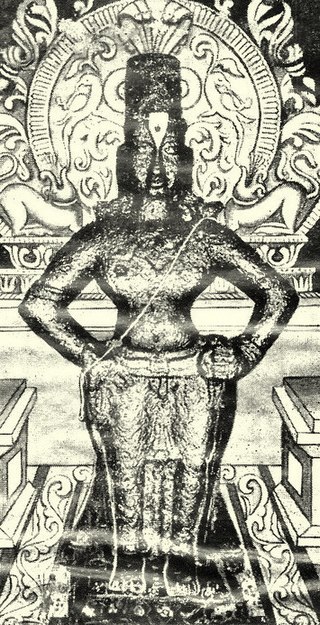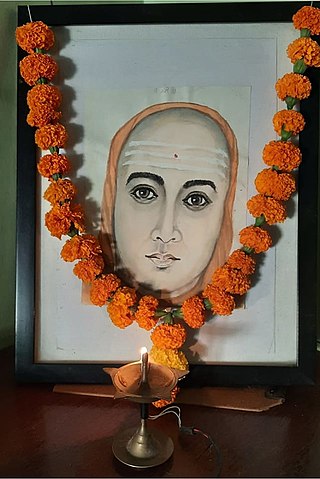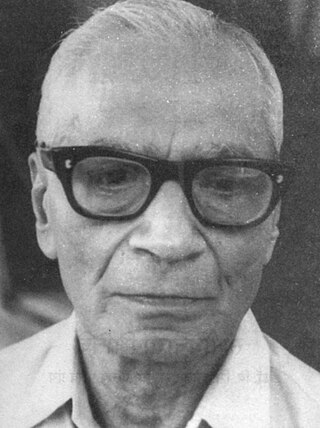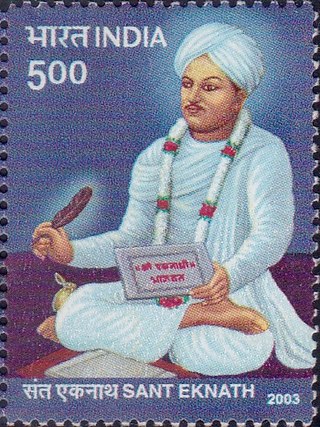Related Research Articles

Marathi is an Indo-Aryan language predominantly spoken by Marathi people in the Indian state of Maharashtra. It is the official language of Maharashtra, and an additional official language in the state of Goa used to reply provided the request is received in Marathi. It is one of the 22 scheduled languages of India, with 83 million speakers as of 2011. Marathi ranks 13th in the list of languages with most native speakers in the world. Marathi has the third largest number of native speakers in India, after Hindi and Bengali. The language has some of the oldest literature of all modern Indian languages. The major dialects of Marathi are Standard Marathi and the Varhadi dialect.

Shri is a Sanskrit term denoting resplendence, wealth and prosperity, primarily used as an honorific.

Sant Dnyaneshwar, also referred to as Dnyaneshwar, Dnyanadeva, Dnyandev or Mauli or Dnyaneshwar Vitthal Kulkarni (1275–1296), was a 13th-century Indian Marathi saint, poet, philosopher and yogi of the Nath and Varkari tradition. In his short life of 21 years, he authored Dnyaneshwari and Amrutanubhav. These are the oldest surviving literary works in the Marathi language, and considered to be milestones in Marathi literature. Sant Dnyaneshwar's ideas reflect the non-dualistic Advaita Vedanta philosophy and an emphasis on Yoga and bhakti towards Vithoba, an incarnation of Lord Vishnu. His legacy inspired saint-poets such as Eknath and Tukaram, and he is one of the founders of the Varkari (Vithoba-Krishna) Bhakti movement tradition of Hinduism in Maharashtra. Dnyaneshwar undertook samadhi at Alandi in 1296 by entombing himself in an underground chamber.

Ramdas, also known as SamarthRamdas or Ramdas Swami, was an Indian Hindu saint, philosopher, poet, writer and spiritual master. He was a devotee of the Hindu deities Rama and Hanuman.
Mahanubhava refers to Krishnaite Hindu denomination in India that was founded by Sarvadnya Shri Chakradhar Swami ,an ascetic and philosopher who is considered as a reincarnation of Krishna by his devotees Some sources list the founders as Chakrapani and Govinda Prabhu with Chakradhara as the first "apostle" and propagator of Mahanubhava Pantha. Mahanubhava Sampradaya was formally formed in modern-day Varhad region of Maharashtra in 1267 CE. It has different names such as Jai Krishni Pantha in Punjab and Achyuta Pantha in Gujarat. Mahanubhava Pantha was also known as Paramarga by its followers in 13th century. Nagadevacharya, also known as Bhatobas, became the head of Sampradaya after Chakradhara.

Sant Sopandeo was a sant of the Varkari and also the younger brother of Dnyaneshwar.

Jainism has been present in Maharashtra since ancient times. The famous Ellora Caves demonstrate that Jainism was part of a thriving religious culture in Maharashtra in premodern times.

Vithoba, also known as Vitthala, and Panduranga, is a Hindu god predominantly worshipped in the Indian state of Maharashtra and Karnataka. He is a form of the god Vishnu in his avatar: Krishna. Vithoba is often depicted as a dark young boy, standing arms akimbo on a brick, sometimes accompanied by his consort Rakhumai.

Shree Narasimha Saraswati Swami or Shree Nrusimha Saraswati Swami was an Indian guru of Dattatreya tradition(sampradaya). According to the Shri GuruCharitra, he is the second avatar of Dattatreya in Kali Yuga after Sripada Sri Vallabha.

Shri Swami Samarth Maharaj also known as Swami of Akkalkot was an Indian Hindu saint of the Dattatreya Tradition. He lived during the nineteenth century from 1858 to 1878 and is a known spiritual figure in various Indian states including Karnataka and Maharashtra. Swami Samarth traveled all across the Indian subcontinent and eventually set his abode at Akkalkot, a village in present-day Maharashtra. He is thought to have arrived at Akkalkot on a Wednesday, during either September or October in 1856. He resided at Akkalkot for close to 22 years.

Tukdoji Maharaj, born on 30 april 1909 died on 11 october 1968 was a spiritual saint from, India. He was born in 1909 in a poor family in the village of Yawali in Amravati. He was a disciple of Aadkoji Maharaj. Tukdoji Maharaj was involved in social reforms in the rural regions of Maharashtra, including construction of roads. Tukdoji maharajwrote Gramgeeta which describes means for village development. Many of the development programs started by him have continued to work efficiently after his death. He was once even claimed as a mad by one of the British officers.
Thanjavur Marathi, also spelled as Tanjore Marathi, is a dialect of Marathi spoken by Thanjavur Maharashtrians who migrated south, along with Shivaji's half brother Venkoji, to the areas surrounding the city of Thanjavur in Tamil Nadu, India back in the 17th century.

Vishnu Bhikaji Kolte (1908–1998), popularly called Bhausaheb Kolte was a Marathi writer and researcher of old Marathi literature. He hailed from Maharashtra, India. He served as Vice chancellor in Rashtrasant Tukadoji Maharaj Nagpur University.
Mukundraj was one of the earliest Marathi literary figures poet. Some earlier scholars dated him to the 12th century.
Ramchandra Chintaman Dhere was a Marathi writer from Maharashtra, India.
Shri Chakradhara, also known as Sarvagya Shri Chakradhar Swami or Kunwar Haripaladeva was an Indian saint and philosopher, who is considered as an avatara of Krishna by his disciples and one of the most important exponents of the Dvaita tradition within Hinduism. He is the founder of Mahanubhava Sampradaya of Krishnaism. Shri Chakradhar Swami advocated worship of Lord Krishna and preached a distinct philosophy based on Bhakti. He did not recognize caste distinctions, and like Buddha had only two others viz the householder and recluses. Some sources claim that Chakrapani Prabhu and Govinda Prabhu as the originators of Mahanubhava doctrine and Chakradhara as the first apostle who systematized Mahanubhava as a school of Bhakti philosophy. Chakradhara's incarnation day is observed on the Tithi of Bhadrapada Shukla Dwitiya.

Eknath (1533–1599), was an Indian Hindu saint, philosopher and poet. He was a devotee of the Hindu deity Vitthal and is a major figure of the Warkari movement. Eknath is often viewed as a spiritual successor to the prominent Marathi saints Dnyaneshwar and Namdev.
Padmaja Phenany Joglekar is a Hindustani Classical singer. She is a disciple of Pandit Jasraj. She was awarded the Padma Shri Award in 2001.
Mhaimbhat was one of the earliest followers of Chakradhar Swami and the Mahanubhava sect, and author of Leela Charitra, the first biography written in the Marathi language.
References
- ↑ Nagendra (1988). Indian Literature. Delhi: Prabhat Prakashan. p. 205. OCLC 19812121.
- ↑ Novetzke, Christian Lee (18 October 2016). The Quotidian Revolution: Vernacularization, Religion, and the Premodern Public Sphere in India. Columbia University Press. p. 342. ISBN 978-0-231-54241-8.